|
 Marasmius micraster Marasmius micraster
BiostatusPresent in region - Indigenous. Non endemic
Images (click to enlarge)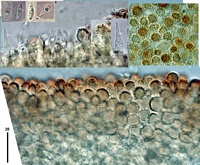
Caption: Top left: spores & two kinds of cheilocystidia. Top right: cap cells. Botom: section through cap.
Owner: J.A. Cooper | 
Caption: Fig. 13 (1-6). Marasmius micraster Petch (ZT 69-32). - 1. Basidiomes. - 2. Basidiospores. - 3.
Basidia. - 4. Cheilocystidia a). - 5. Cheilocystidia b). 6. Pileipellis. | 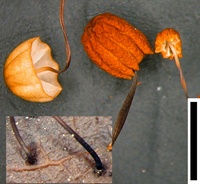
Caption: scale=2mm
Owner: J.A. Cooper | 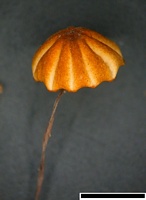
Caption: scale=2mm
Owner: J.A. Cooper | 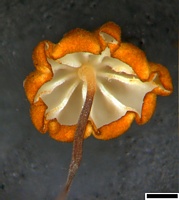
Caption: scale=0.5mm
Owner: J.A. Cooper | 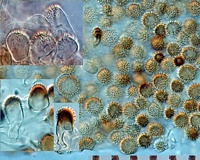
Caption: cap cells
Owner: J.A. Cooper | 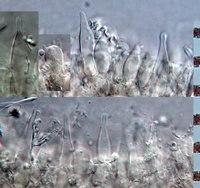
Caption: cheilocystidia
Owner: J.A. Cooper | 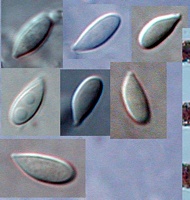
Owner: J.A. Cooper | |
Article: Desjardin, D.E.; Horak, E. (1997). Marasmius and Gloiocephala in the South Pacific Region: Papua New Guinea, New Caledonia, and New Zealand taxa. Bibliotheca Mycologica 168: 152 p.
Description: Pileus 2-5(-7) mm diam, hemispherical to convex throughout maturation, disc neither depressed nor
papillate, margin plicate; surface dull, dry, glabrous; evenly rusty brown to pale soot brown, or with a
darker disc, dried orange to pale orangish brown. Texture tough, membranaceous; context very thin.
Lamellae subfree to adnexed, subdistant (9-12), lamellulae absent, seldom with 1-series, white to cream;
edges even, pale rusty brown to pale brown. - Stipe15-60(-75) x 0.3-0.5 mm, central, cylindrical, equal,
wiry, glabrous, shining, insititious, apex cream, black elsewhere; rhizomorphs absent.- Odor and taste
not distinctive.
Basidiospores 9-11(-12) x (3.5-)4.0-5.0(-5.5) µm, ellipsoid to subfusoid, sometimes slightly curved in
profile, smooth, thin-walled, hyaline, inamyloid.- Basidia 18-30 x 7-9 µm, clavate, 4-spored, clamped. -
Cheilocystidiaof 2 types: a) Rotalis-type cells with main body 12-30 x 8-15 µm, broadly clavate, hyaline,
thin-walled to slightly thick-walled; divergent setulae 1-2 x 0.5-1.0 µm, cylindrical, thin-walled to
thick-walled, hyaline to pale tawny; b) fusoid to ventricose cystidia with elongate neck, 20-36 x
4-10 µm, thin-walled, hyaline.- Pleurocystidia absent.- Pileipellis hymeniform, not mottled,
composed of Rotalis-type cells; main body (10-)15-25 x 7-12 µm, clavate to broadly clavate,
reddish brown, thick-walled (1-4 µm ); divergent setulae 1-2 x 0.5-1.0 µm , cylindrical; some
cells lacking setulae interspersed among Rotalis-type cells; pileocystidia absent.- Pileal and
tramal tissue inamyloid, Stipe tissue monomitic; cortical hyphae cylindrical, densely setulose
at stipe apex, smooth or with scattered setulae at stipe base, brown, dextrinoid.- Caulocystidia
absent.- Clamp connections present.
Habitat: Habit, habitat and distribution.- Solitary, in groups on rotting leaves of Pseudopanax
crassifolium (Scheffleraceae) or Pittosporum eugenioides (Pittosporaceae). Malaya, New
Zealand, Sri Lanka.
Notes: Marasmius micraster is characterized by convex, plicate, rusty brown to soot brown pilei
(yellowish brown to blackish brown in Sri Lankan material), subdistant (9-12), non-collariate
lamellae with brownish edges, a long (15-60 mm), glabrous, insititious stipe, basidiospores 9-11 x 4-5 µm, two types of cheilocystidia, and the absence of both pileocystidia and
caulocystidia. Marasmius micraster is most closely allied with the southern European M.
corbariensis (Roum.) Singer, which differs only in forming strongly intervenose, non-marginate lamellae, a furfuraceous stipe, and scattered pleurocystidia. Marasmius
sphaerodermatoides Singer, described from Argentina, is also similar, but differs in forming
shorter basidiospores (7-8 µm long), scattered pleurocystidia, and two types of caulocystidia
(fide Singer, 1989).
Marasmius micraster was first described from Sri Lanka (Petch, 1948), with pilei reported as
2-3 mm diam and stipes 10-30 mm long. Apparently there is a wide range of basidiome size
exhibited by M. micraster. For example, of the two specimens collected on Pseudopanax
leaves, Horak # 67-228 forms pilei 23 mm diam and stipes 15-30 mm long, whereas Horak #
69-32 forms pilei 4-7 mm diam and stipes 30-75 mm long. Moreover, the basidiospores of the
material collected on Pittosporum leaves (Horak # 69-57) are narrower than those of the
material collected on Pseudopanax, measuring 10-12 x 3.5-4.0 µm vs. 9-11 x 4.0-5.0
respectively. Because all other features are indistinguishable, we do not consider these
differences taxonomically significant. Corner (1996) recently described M. micraster var.
brevipes Corner from Singapore, differing only in forming a short stipe (6-10 mm) and fewer
lamellae (4-7).
|